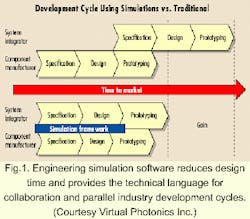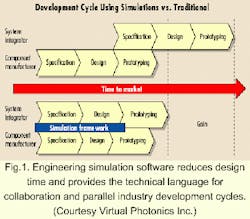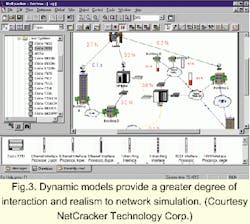Simulation design software boosts optical networking
Designing telecommunications networks, not to mention the hardware and software necessary to make them work, involves extensive testing and retesting of every critical component and feature. The expense can be huge, particularly if a detailed model of the network must be built to test its abilities. During the last 10 years, however, companies have sprung up to offer alternatives to the "network in a lab" technique for the design and testing of the various components and architectures of large and small networks.
Today, software programs can simulate the causes and effects of building networks and network products and can incorporate any number of new designs and ideas. In an ever-changing industry like fiber-optic telecommunications, these programs offer the ability to incorporate the latest architectures and technologies into networks and network hardware while offering lower cost, uninterrupted service, user-friendliness, reliability, and high verisimilitude.
There are companies that focus directly on particular network components. There are also companies that are producing software that simulates entire global network architectures. Then there is everything in between.
There are, however, three distinct areas that seem to stand out in the growing realm of network simulation software production. First, there are products dedicated to telecommunications equipment engineering. These sophisticated engineering tools are useful in the design of new network equipment such as routers, switches, wavelength-division multiplexing (WDM) equipment, and other optical transmission components. Second, there is software for network-management simulation that re-creates network-management environments without the extensive cost of actual hardware devices. Third, there is simulation software for virtually constructing entire network systems to portray a network's entire operation through traffic-based animation features. These three simulation software areas--device engineering, network management, and network operation--differ in the industry space they inhabit but are similar in the advantages they offer to their customers.
Traditionally, network equipment prototypes have been built by connecting real components in labs and testbeds, a tedious and costly undertaking that usually involves change after change during the design process. To address this slow, costly, and error-prone process, companies have developed simulation software for use by engineers looking to incorporate brand-new technology ideas into the latest telecommunications network equipment.
Optiwave Corp. offers EDFA_Design, engineering design software that addresses all aspects of erbium-doped fiber amplifier (EDFA) engineering. Artis Software Corp., a San Francisco-based company founded in 1989, produces a suite of products targeting network engineers that require modeling and simulation tools for validating the performance of critical systems. OptSim is a tool conceived for the design and performance prediction of optical transmission systems. Artifex models and simulates complex hardware and software discrete-event systems and components such as new protocols, routers, and other innovative networking architectures, including all-optical protection routing and WDM protocols.
"Engineers need flexibility to design their new products with the required level of detail while taking into account the proprietary features that make their products unique," says Marco Baldassari, chief executive at Artis. "Capacity-planning simulation tools normally provide models for existing network products that can be configured and connected according to predefined architectures."
More than including a library of existing products, a design tool for the engineers of tomorrow's networks must be effective to describe a new product's functionality and behavior both quickly and accurately, providing virtual prototyping feedback to the design process.
"Thanks to the virtual prototyping provided by modeling and simulation software, engineers can cut their time to market and improve the product's robustness at much lower costs," says Baldassari. "Engineers benefit from a feedback on their work as they design, adjusting and refining their systems much earlier than [when] the first prototype is built. Debugging a prototype is also much more costly, painful, and difficult than running controlled simulations on your laptop to simulate all critical situations. In the end, the work is more productive and quality improves."
Virtual Photonics Inc. (VPI), the result of the merger of simulation product manufacturers BneD GmbH and Virtual Photonics, creates design tools that can tackle the huge bandwidth created by advances in WDM technology, while also meeting the challenges of the first optical metropolitan networks. VPI offers the Photonic Transmission Design Suite (PTDS), which boasts the ability to build a complex, dispersion-managed, 16-channel WDM system, with a total transmission length of 10,000 km, in less than 20 min.
VPI's executive vice president, Harald Hamster, says time to market is the driving force behind today's simulation software. The rapid introduction of DWDM networking equipment is the catalyst for customer demand in getting products to market as quickly as possible. "Our customers tell us they simply must get their new products and services out the door so network providers can meet the escalating demand for bandwidth," says Hamster. "They use PTDS software to speed up development activities and tendering processes among their vendors."
To complement and focus the trial-and-error processes of physical experimentation, engineers have used computer simulations for many years. The current surge in demand for simulation software, says Hamster, is powered by the pressure to try new techniques that fully use fiber-optic bandwidth, algorithms, and computer-processing speed.
"Simulations that used to run for days now take hours and minutes," says Hamster. "Soon, you'll see the entire network on a laptop when, just a few years ago, you needed a warehouse of computer power to tackle the same exercise. PTDS features semi-analytical algorithms that yield more than 100-fold acceleration in modeling the amplitude and phase margins of WDM optical-fiber links."These design software tools offer engineering simulation modules dealing with everything from optical sources to various equipment platforms to optical layers and different network architectures, including mesh and ring configurations. The value of such flexibility to telecommunications equipment manufacturers lies in their abilities to make, exchange, and document data in a much more functional format (see Fig. 1).
Design software can be flexible, comprehensive, and easy to use, yet it can deliver highly sophisticated mathematical and physical approaches to the desktop, allowing engineers to focus on the main task. "Nonlinear fiber propagation just can't be done using an Excel spreadsheet," says Hamster. With the current generation of software, "you can rapidly study specific designs and work out whether they are applicable-like whether an old link with old fiber and amplifiers can support high-speed WDM equipment. Design teams can create, drag, and drop accurate models for the latest components, subsystems, and network elements into a link, system, or network simulation and assess performance, cutting months from the rollout schedule."
The market for simulation tools appears to be growing, at least as fast as demand for optical communications equipment. This growth equates to a short supply of skilled designers, and effective visualization tools are essential to enhance productivity because they can embed specialist knowledge in an easy-to-use environment. But how difficult is it to maintain current and accurate design software in the face of new and constantly changing optical technologies?
"Design tools are at the frontier of technology," says Hamster, "and today's software has to build the next generation of optical products. In addition to our development team at VPI, we look to industry luminaries, research centers, and universities. We give PTDS software to about a hundred universities to stimulate innovation. Our customers further drive the optics revolution by stretching technical limits. They're hungry for time-to-market advantage, and play a central role in our development process by putting our products to use as fast as we can make them."
The second application for network simulation software is in the management realm of telecommunications networking. Here again, software takes the place of many devices that otherwise would have to physically be set up in a laboratory environment...at considerable expense. Besides the high cost, problems encountered with such a "lab testbed" include the need for huge amounts of components to test a nightmarish number of possible scenarios, interoperability issues, time-to-market concerns, and the future growth or scalability issues created by new technologies.Software that can simulate the effects and results of network-management techniques can save money, reduce the need for physical space and infrastructure, provide flexibility of interfaces, and create unlimited simulated scenarios. One very serious problem that is eliminated derives from the number of simple network-management protocol (SNMP) agents and management information bases (MIBs) being embedded or being introduced into all kinds of equipment, resulting in an explosion of interoperability cases. Management simulation software gives customers the opportunity to address these and other issues more quickly and with lower costs (see Fig. 2).
According to Dwight Linn, head of sales and business development at Gambit Communications Inc., a simulation software company active in this area, "Our simulation tools enable customers to develop new SNMP-based network-management applications. What these customers have in common is the need to hold down development costs while building robust new products. We give them the ability to test a wide class of SNMP-managed devices with their software and run more tests in less time than any other testing method would allow."
Gambit's flagship product, known as MIMIC (Multiple Instance Management Information Concentrator), is designed to lower the total cost of network-management-system ownership by complementing laboratories used to develop, test, evaluate, support, demonstrate, and provide training for SNMP-based management applications. The company, formed in 1995 and based in Nashua, NH, has incorporated in MIMIC such features as multiple SNMP agents in a single box, customized MIB configurations, real-time modifiable simulations, and the ability to record snapshots of real world scenarios and simulate them almost immediately. Current demand for these tools makes for a good niche within the simulation software realm.
"These network-management simulation tools for SNMP have become invaluable for testing, developing, and training, as well as sales and marketing demos of new management applications," says Linn. "This is a relatively new application for simulation technologies. We are providing ease-of-use enhancements to each new software release. We also support increasingly larger simulations for the kind of scalability testing necessary to improve reliability and availability of networks."
Network-management simulations can also be valuable to a company as a training tool to teach new personnel how to properly react to routine and unforeseen situations without affecting the actual network. The multivendor nature of carrier networks, the mixed use of applications packages, and the critical nature of operations "uptime" make key operator training a high-priority business.
"Only through the use of simulation tools can operators be safely trained on important but dangerous tools and methods without jeopardizing production networks," says Linn. "The training can include troubleshooting, problem management, and interoperability testing."
Simulation software takes on a broader meaning when it is applied to designing entire telecommunications networks, especially with the sophistication involved in today's integration of voice, data, and video applications. These products assist network vendors, system integrators, and network managers in designing, modeling, and presenting workable network designs and solutions using the latest technologies and features.
Both network hardware vendors and independent software firms offer network simulation tools for carrier customers. For example, NetCracker Technology Corp., a Waltham, MA-based network software manufacturer, markets a suite of products for designing networks. Both NetCracker Designer and NetCracker Professional products include animation that visually shows an accurate portrayal of the network's operation and a feature that enables the independent "discovery" of networks, called Autodiscovery. This feature works with or without an interface to HP Openview Node Manager for customers currently using HP Openview. Import of data is also provided from Visio, allowing automatic conversion to NetCracker files."The competitive advantage of NetCracker's Autodiscovery feature is that we match what is discovered in the network to our database," says Bonnie Ward, vice president of NetCracker. "We then pull in all database characteristics of the device, which gives the users more information about their networks."
A key feature in network-design software is the ability to incorporate the latest in available network equipment into your network. For instance, with the click of a button, the user can pull a particular router off the network and replace it with a superior product that offers more desirable features regardless of the vendor. With this flexibility, the network designer can compare functionality, analyze the advantages of new technologies, and even compare the prices of similar products before deciding on the best solution.
The advantages of a product that builds an entire network via a proactive computer simulation model are pretty obvious. The ability to see the effects of architectural changes in the network without interrupting any service or spending money to test new products is one boon. The ability to make changes on the fly to evaluate "what if" scenarios and see the results instantly on a screen would be appealing to anyone with the responsibility to make accurate and prudent decisions about how to best spend the company's money.
"Network simulation software enables you to analyze alternative network options before committing to a new design," says Ward. "The result is substantial savings of time and money."
Simulation software tools for telecommunications applications such as equipment design, network management, or network development are being applauded by industry analysts as useful and cost-effective methods for improving today's networks.
"Good network design and planning are prerequisites for maintaining the ever-changing network of fast-moving corporations," says Michael Howard, chief executive at Infonetics Research Inc. His thoughts are echoed by Richard Villars, director of network software research at International Data Corp. Villars believes sound network planning and design is a formidable challenge for managers as the sheer number and bandwidth demands of new applications grow. Network simulation software provides a visual and easy-to-use solution that enables managers to more effectively maintain and upgrade the corporate networks supporting mission-critical applications.
Customers are offering testimony to the value of simulation in the telecommunications world. Management-software developers, for example, sometimes face difficulties in getting management systems to market to coincide with the latest and greatest network platforms. John Weber, a network-management consultant with Bigtime Software, says the simulations enable the development of management software in advance of new hardware devices. "By testing against models of devices still under development," says Weber, "we were much further ahead with the software implementation when the actual devices became available."



